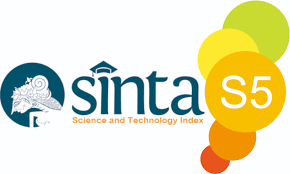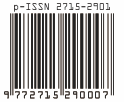REACTION DIFFERENCES GROWTH INVESTOR AND VALUE INVESTOR TO EX-DIVIDEND DATE AND CHANGES IN DIVIDEND: EMPIRICAL STUDY ON LQ45 STOCK PERIOD 2008-2010
Abstract
This research analyzes the differences in reactions growth investor And value investor to ex-dividend date and changes in dividend policy on LQ45 shares during the 2008-2010 period. Using approach event study, this study evaluates abnormal return And trading volume activity around ex-dividend date. The research results show that growth investor tend to do profit-taking before ex-dividend date, whereas value investor retain shares to obtain dividends. Dividend increases result abnormal return positive that is more appreciated by value investor, temporary growth investor tend to give neutral to negative responses. Conversely, a decrease in dividends results abnormal return negative which has more impact on value investor, temporary growth investor more tolerant of these changes. These findings support the theories of Dividend Signaling, Tax Preference, and Clientele Effect, which explain how investors with different preferences respond to dividend policy. This research provides insight for investors and companies in developing investment strategies and dividend policies that suit the characteristics of their investor base.
References
Baker, M., & Wurgler, J. (2004). A catering theory of dividends. The Journal of Finance, 59(3), 1125-1165.
Bank Indonesia. (2021). Indonesian Economic and Financial Statistics (SEKI). Jakarta: Bank Indonesia.
Bhattacharya, S. (1979). Imperfect information, dividend policy, and "the bird in hand" fallacy. The Bell Journal of Economics, 10(1), 259-270.
Indonesia stock exchange. (2022). IDX Statistics 2022. Jakarta: BEI.
Chen, J., & Liu, Y. (2022). The Impact of Dividend Changes on Different Types of Investors: A Study of Asian Markets. Journal of International Financial Markets, Institutions and Money, 76(1), 101464. https://doi.org/10.1016/j.intfin.2022.101464
Graham, B., & Dodd, D. (2008). Security Analysis: Sixth Edition. McGraw-Hill Education.
Gordon, M. J. (1963). Optimal investment and financing policy. The Journal of Finance, 18(2), 264-272.
Hartono, S., & Wijaya, R. (2023). Analysis of Differences in Abnormal Return and Trading Volume Activity Before and After Ex-Dividend Date on LQ45 Shares. Scientific Journal of Management and Business, 25(1), 45-62. https://doi.org/10.30596/jimb.v25i1.9876.
Jensen, M. C. (1986). Agency costs of free cash flow, corporate finance, and takeovers. The American Economic Review, 76(2), 323-329.
Johnson, M. F., & Lee, S. H. (2020). Dividend Changes and Investment Strategies: Evidence from Global Markets. Journal of Banking & Finance, 112(3), 105678. https://doi.org/10.1016/j.jbankfin.2020.105678
Kumar, R., & Shah, V. (2022). Investor Behavior around Ex-Dividend Dates: Evidence from Emerging Markets. Pacific-Basin Finance Journal, 71(2), 101695. https://doi.org/10.1016/j.pacfin.2022.101695,
Kusuma, A., & Wibowo, B. (2020). Investor Characteristics and Investment Decisions: Study on Ex-Dividend Date on the Indonesian Stock Exchange. Indonesian Journal of Accounting and Finance, 17(2), 169-187. https://doi.org/10.21002/jaki.2020.10
Litzenberger, R. H., & Ramaswamy, K. (1979). The effect of personal taxes and dividends on capital asset prices: Theory and empirical evidence. Journal of Financial Economics, 7(2), 163-195.
Michaely, R., Thaler, R. H., & Womack, K. L. (1995). Price reactions to dividend initiations and omissions: Overreaction or drift? The Journal of Finance, 50(2), 573-608.
Miller, M. H., & Modigliani, F. (1961). Dividend policy, growth, and the valuation of shares. The Journal of Business, 34(4), 411-433.
Nguyen, T. H., Zhang, X., & Wang, L. (2023). Dividend Policy and Stock Price Behavior: Evidence from Growth and Value Stocks during COVID-19. International Review of Financial Analysis, 85(1), 102458. https://doi.org/10.1016/j.irfa.2023.102458.
Financial Services Authority. (2021). Indonesian Capital Market Statistics 2021. Jakarta: OJK.
Park, S. J., & Kim, H. (2021). Ex-Dividend Day Trading Patterns: Analysis of Different Investor Types. Journal of Financial Economics, 139(3), 849-867. https://doi.org/10.1016/j.jfineco.2021.01.006.
Pratama, I. G. B., & Dharmadiaksa, I. B. (2021). Capital Market Reaction to Dividend Announcements During the COVID-19 Pandemic. Scientific Journal of Accounting and Business, 16(1), 163-178. https://doi.org/10.24843/JIAB.2021.v16.i01.p12
Pettit, R. R. (1972). Dividend announcements, security performance, and capital market efficiency. The Journal of Finance, 27(5), 993-1007.
Rahmawati, N., & Sudarsono, H. (2021). The Impact of Dividend Policy on Company Value: The Moderating Role of Investor Type in IDX30 Companies. Journal of Islamic Economics and Finance, 7(2), 213-228. https://doi.org/10.20885/jeki.vol7.iss2.art7.
Rodriguez, A., & Martinez, C. (2021). Dividend Announcements and Stock Price Reactions: A Comparative Study of Growth and Value Investors. Review of Financial Studies, 34(5), 2265-2299. https://doi.org/10.1093/rfs/hhaa148.
Ross, S. A. (1977). The determination of financial structure: The incentive-signalling approach. The Bell Journal of Economics, 8(1), 23-40.
Sari, L. P., & Putra, I. N. W. A. (2022). The Effect of Dividend Announcements on Market Reactions: Study of Consumer Sector Companies on the IDX. Journal of Accounting, 14(2), 89-104. https://doi.org/10.24843/JA.2022.v14.i02.p07
Smith, R. B., & Anderson, K. L. (2020). Market Reactions to Dividend Policy Changes: A Behavioral Finance Perspective. Journal of Behavioral Finance, 21(4), 415-430. https://doi.org/10.1080/15427560.2020.1774892.
Wang, L., Chen, Y., & Zhang, W. (2021). Investor Heterogeneity and Dividend Policy: Evidence from the Technology Sector. Journal of Corporate Finance, 66(1), 101878. https://doi.org/10.1016/j.jcorpfin.2021.101878.
Williams, J. B. (1938). The Theory of Investment Value. Harvard University Press.



















